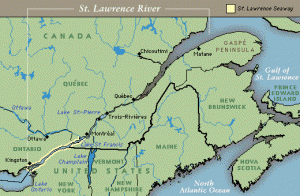The following is a footnote to Ed Lemond’s post, here.
In several places Frye remarks that the St. Lawrence is also a Leviathan for ships coming from Europe. They enter into the Gulf of St. Lawrence like Jonah entering into the belly of the whale. One of the places Frye uses the figure is in “Haunted by Lack of Ghosts”:
[T]he British painter and writer Wyndham Lewis, who spent some years in Canada during the Second World War, makes this comment about A.Y. Jackson, one of the twentieth-century Group of Seven landscape painters, perhaps with an underlying allusion to the Carman poem already cited: “Jackson is no man to go gathering nuts in May. He has no wish to be seduced every Spring when the sap rises–neither he nor nature are often shown in these compromising moods. There is something of Ahab in him: the long white contours of the Laurentian Mountains in mid-winter are his elusive leviathan.”
The Leviathan also recurs in Wilfred Watson’s fine poem on another Canadian painter, the British Columbian Emily Carr:
Like Jonah in the green belly of the whale
Overwhelmed by Leviathan’s lights and liver
Imprisoned and appalled by the belly’s wall
Yet inscribing and scoring the uprush
Sink vault and arch of that monstrous cathedral,
Its living bone and its green pulsing flesh–
Old woman, of your three days’ anatomy
Leviathan sickened and spewed you forth
In a great vomit on coasts of eternity. [Emily Carr]
The image of being swallowed by the Leviathan is an almost inevitable one for Canada: the whole process of coming to the country by ship from Europe, through the Strait of Belle Isle and the Gulf of Saint Lawrence and then up the great river, suggests it, again a marked contrast to the United States, with its relatively straight north-south coastline. In Pratt’s narrative poem on the building of the Canadian Pacific Railway, Towards the Last Spike, the dragon image appears, the symbol of a nature so totally indifferent to man and his concerns that it is irrelevant to wonder whether it is dead or alive:
On the North Shore a reptile lay asleep–
A hybrid that the myths might have conceived,
But not delivered, as progenitor
Of crawling, gliding things upon the earth . . .
This folded reptile was asleep or dead:
So motionless, she seemed stone dead–just seemed:
She was too old for death, too old for life . . .
Ice-ages had passed by and over her,
But these, for all their motion, had but sheared
Her spotty carboniferous hair or made
Her ridges stand out like the spikes of molochs . . .
Was this the thing Van Horne set out
To conquer? [ll. 870-3, 882-4, 890-3, 899-900]
Van Horne was the builder of the Canadian Pacific Railway, and the stretch of Precambrian shield in northern Ontario was one of his most formidable obstacles.
In the Bible, of course, the Leviathan swallows Jonah, a prototype not only of Emily Carr but of the Jesus who descended to the world of death and hell for three days. In the closely related myth of Saint George and the dragon, Saint George dies along with the dragon he kills, and has to be separately brought to life. What such myths appear to be telling us is that the Leviathan is the monster of indefinite time and space surrounding us on all sides: we are all born inside his belly, and we never escape from it; he is the body of death from which we cannot be delivered. The Christian, Baroque, Cartesian attitude that the white invaders brought from Europe helped to ensure that in Canada the sense of being imprisoned in the belly of a mindless emptiness would be at its bleakest and most uncompromising. As we have seen, the ego’s one moment of genuine dignity in such a situation is the moment either of death or of some equally final alienation. Among the poets of the generation of Roberts, Carman, and D.C. Scott, Archibald Lampman achieved the highest consistent level of poetry, partly because he was prudent enough to stick to elegiac moods. (CW 12: 484–5)
